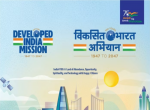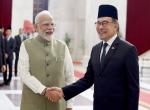A task force set up by the Ministry of Human Resource Development, which was chaired by Prof. Sanjay Dhande, Director, IIT, Kanpur has looked at the question of faculty shortages in Indian universities and colleges. In 2008 it was calculated that on the basis of a teacher-student ratio of 1:13.5 Indian needed another 3,83,000 faculty members. The faculty shortage was as high as fifty-four percent of the needed strength. With the opening of several new Indian Institutes of Technology, Indian Institutes of Management and National Institutes of Technology, etc., the faculty shortage has worsened in the current year. This is the position of our institutions of higher learning. Can one imagine the situation at the feeder level, that is, the schools?
Let us visit the rural school scenario. Primary schooling is the responsibility of the panchayat. The majority of village schools are housed in buildings which would shame cattle shed. The average village school has no furniture except a table and a chair for the teacher. Students sit on the floor on a piece of jute matting (tat-patti) if they are lucky, or on the bare earth if they are not. There probably is a blackboard, but it is of poor quality and chalk sticks are not necessarily available. There are no other teaching aids. The children have no desk on which to rest their slates or copybooks and all of them sit hunched forward, risking curvature of the spine, scribbling the alphabet or simple sums. As likely as not it would be a single teacher school, with one teacher taking care of five classes. What sort of education such a school would impart beggars the imagination. It is not surprising that there is a shockingly high dropout rate in the village schools. Instead of improving the infrastructure and the student teacher ratio government adopts gimmicks such as a mid-day meal programme to keep children in school. This has not worked.
The panchayat or municipality administered middle or higher secondary school is marginally better than the village primary school. Because many village children drop out at primary level it is only the children of the relatively more affluent village and small town people who come to these schools. Even here the quality of education is miserable and drop out is high. On top of this extremely rickety base is erected our structure of our higher education. The average mofussil college or university is anything but a temple of learning. These institutions exist to churn out degree holders who believe that a degree will improve their employability in the market. Actually most of these graduates are unemployable because they may be literate but they are not educated. The tragedy is that this is not confined only to the traditional arts and science colleges alone. A very large number of technical colleges and management institutions which have mushroomed are no better than the moffusil colleges. Of course they occupy territory just contiguous to the miserable school education base, but as institutions of learning they are worthless.
On top of all this heap of rubbish are our elitist colleges and universities. Loyola College, Madras, St. Stephen’s College, Delhi, St. Xavier’s College, Bombay, Allahabad University as it once was, and Isabella Thoburn College, Lucknow are some examples of such colleges. Some of the older engineering colleges and medical colleges also had a name, which is now at least partially eroded. There was a time when Government College, Lahore and the Thompson College of Engineering, Roorkee, were names to be reckoned with. These elitist colleges are fed by the cream of our public school system or certain government schools which have built an image of their own. These are the colleges which announce cut-off marks in the range of ninety-eight percent to hundred percent. King of the castle are the Indian Institutes of Technology, Indian Institutes of Management, Indian Institutes of Information Technology, the Indian School of Mines and some medical institutions like the All India Institute of Medical Science and the Christian Medical College, Vellore. These institutions invite the absolute cream of our school leaving children. These children largely come from top quality, high fee charging elite schools and a child who has come through the normal schooling system can hardly hope to get a toe-hold in these institutions. However, India being what it is, with an absolutely mindless expansion of even these institutions we have downgraded all of them because whereas we have been able to build some physical infrastructure the faculty is simply not available. Having first-rate students is not enough -- there has to be a sufficiency of equivalent faculty to guide the students. It is in this context that the report of the Dhande Committee becomes all the more significant.
It would be a very stupid architect or engineer who builds the super structure of a house without laying the foundation. Such a house cannot survive. Therefore, all education reforms have to be start with the school. In this bleak landscape there is small ray of hope. Rajiv Gandhi, as Prime Minister, initiated a programme for building Navodaya Schools which are located only in rural areas and which give admission only to rural children. There are only about 560 such schools in India, with perhaps one per district. They have a reasonably good infrastructure of teaching blocks, hostels, laboratories, furniture and teaching aids. They are residential and their students represent a complete cross-section, caste wise, income wise and religion wise of village society. There is a reasonably good contingent of teachers. Education, hostel facilities, food, etc., are all free and these schools are not allowed to charge any fee. The desire to learn is great in rural areas, the enthusiasm of the students to better their own lives is so high that given at least the minimum facilities the students of these schools have outstripped every school in India in CBSE examination results.
I had the opportunity, when Madhav Rao Scindia was Minister for Education, to look at a number of Central Schools and Navodaya Schools all over the country and I was most gratified to see how well the Navodaya Schools have progressed. When Dr. Manmohan Singh became Prime Minister in 2004 I suggested him that we should have ten thousand such schools to start with. Sometimes early in 2008 I was informed by the Department of School Education, HRD Ministry that not only had the Prime Minister considered my suggestion as fit for implementation, but that he had announced in his speech from the Red Fort on 15th August 2007, that 6000 such model schools would be set up. I felt personally happy that government was thinking along the right lines. To my horror I was informed by the Secretary, School Education, Government of India that the Education Minister, Shri Kapil Sibal and the Deputy Chairman of the Planning Commission, Dr. Montek Singh Ahluwalia had decreed that these schools would be in the public-private mode. I argued vehemently with the minister that this was not proper and that it went against the Prime Minister’s public announcement, but he remained adamant. I was not prepared to take this lying down and once again took up the issue with the P.M. Ultimately I find that 3500 schools are being built in the public domain. On the adage that half a loaf is better than none I welcome whatever is being done, but will not give up my fight to have thousands of good schools set up by government. My reasons for fighting for schools in the public domain are something as under: -
Article 45 of the Constitution is a part of the Directive Principles of State Policy, which directs the State to endeavour to provide free compulsory education to all children until they complete the age of fourteen. The Directive Principles are not justiceable, but Article 45 now becomes a fundamental right after the enactment of the Right to Education Act. Under the Act all children between the age of six and fourteen years are entitled to free education. The entitlement of children now becomes the duty of the State and school education, therefore, has to remain in the public domain. The operational word here is “education”, not “literacy”. This means that the schools to be set up by the State to provide free and compulsory education to every child must have an infrastructure and a sufficiency of trained faculty to provide quality education. The State cannot pass on this burden to private parties by inviting their participation in the process. In any case no company or corporate house will continue to support schools in perpetuity. They may invest in physical infrastructure in order to gain tax relief, but I cannot think of any business house which would agree to a long-term commitment to fund a school or group of schools providing quality education free of cost. Therefore, the State must continue to create schools which bring good education to all, regardless of what this costs. Investment in a power station may bring some additional megawatts of power to the system, but education builds a whole nation. The question is not whether we can afford to educate, but rather whether we can afford not to educate.
If school education is improved then simultaneously higher education must also improve. Not everyone can be a genius in science, technology, management or even humanities, but all students must at least be trained adequately to acquire reasonably good quality higher education. This means that there will have to be investment in the normal run of colleges so that their infrastructure and teaching capability improve. This would narrow the gap between the elitist colleges and the normal colleges. Our purpose is to create a new, educated India in which the thinking capability of all Indians is radically improved. This can only be done by a liberal approach to education in which the purpose is to educate and train and not to merely turn out degree holding morons.
This brings one to the apex of the education system, the institutions we have been proud of. These include the Indian Institutes of Technology and Indian Institutes of Management, such Agriculture Universities as the Punjab Agriculture University, Ludhiana and the Pandit Govind Ballabh Pant University at Pantnagar, the top medical colleges and highly specialised institutions such as the Indian Institutes of Information Technology. In the field of technology alone India needs 8000 Ph.Ds. per year if we are to find a sufficient number of faculty for our higher-level technical colleges. India produces 800 Ph.Ds. in technology per year. Our institutes of management need to look at the Indian scenario and first create models of management in an Indian context. Unfortunately they all look to American business schools whose alumni have played a pivotal role in bringing the American economy to its present sorry state. The Indian Institutes of Management have failed to create a genuinely Indian paradigm of business management.
Somewhere down the line these institutions, which have been recognised the world over for their excellence, have become machines in which at one end we feed the raw material of our prime students and which churn out at the other end a marketable produce, the graduate of an IIT or a MBA of an IIM. When these institutions were set up the business world in India was small but today, with globalisation and expansion of Indian industry, the market is large and demand for these graduates is enormous. Very few are attracted to research and teaching. This is what Prof. Sanjay Dhande has to say about the Indian Institutes of Technology as quoted in the issue of ‘India Today’ dated 18th July, 2011. He states, “Indian society looks at IITs as elite undergraduate institutions. This is unfortunate. IITs should have created an impact in research, postgraduate education, development of technologies for the benefit of society and providing effective academic and intellectual leadership to the society at large. This has not been the case and society should demand more from IITs instead of merely glorifying them as elite undergraduate college. Being national heroes and international zeros is not going to work for long”.
The challenge before India is to completely restructure our school system so that it begins to impart quality education to every child in the country. The challenge is to build institutions of higher learning which attract the school leaving students to a local college of a good standard. The challenge is to take our top most institutions of learning, such as the IIsT and IIsM and to inculcate in the students a desire for research, for teaching and for contributing to society instead of just being factories which produce high value employable products for the private sector here and abroad. That is where education should be going.
-------------------------------------------
Published Date: 17th August, 2011









Post new comment